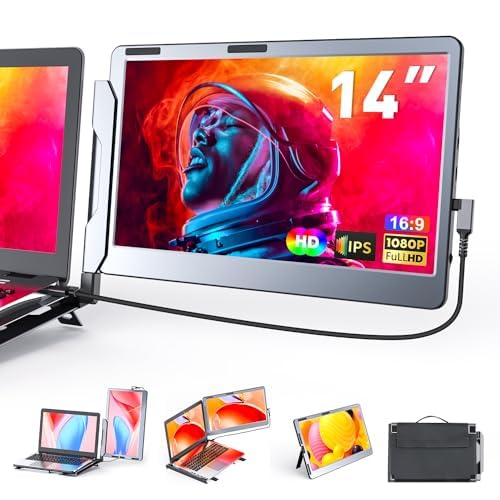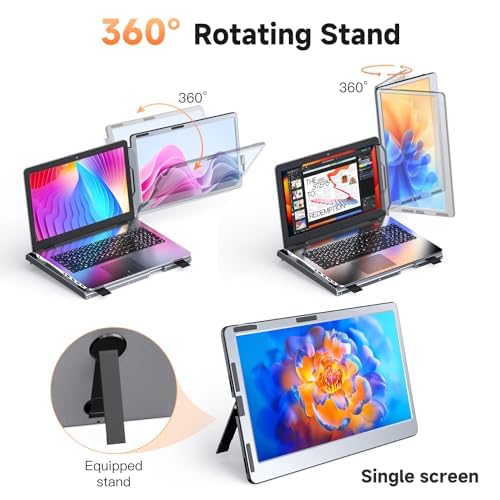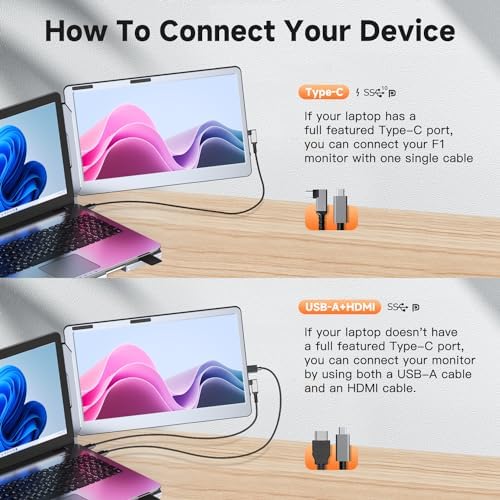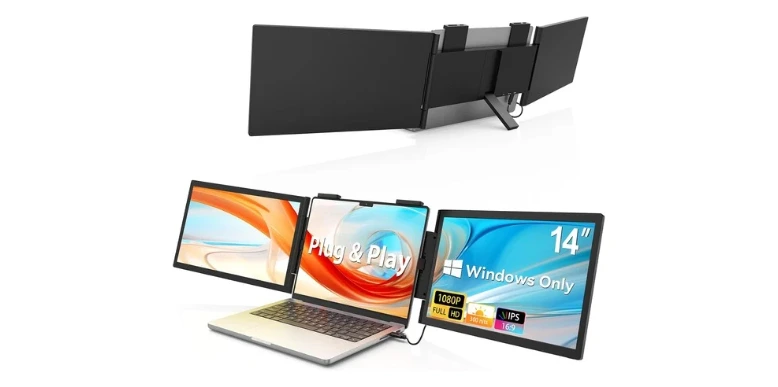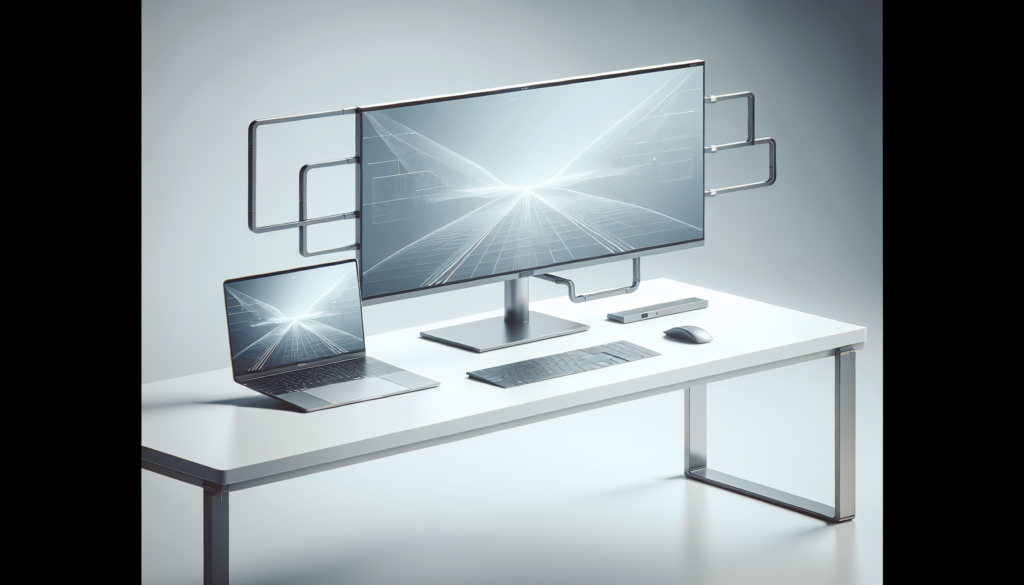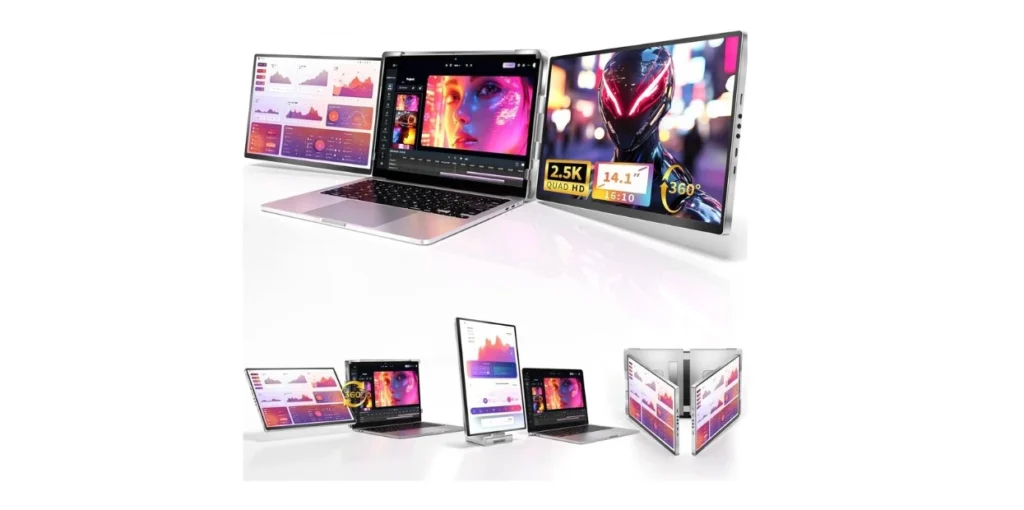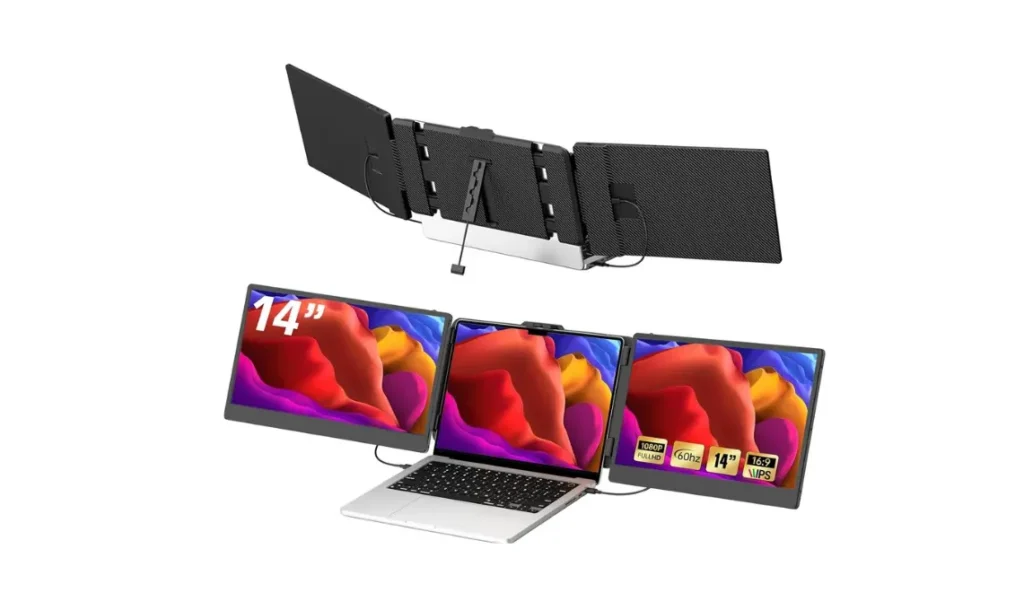Have we ever wanted to open our laptop and have two more screens pop up like an enthusiastic stage crew who finally got their cue?
Why We Wanted A Portable Triple-Screen Setup
We’ve all tried to be efficient while toggling between tabs like a caffeinated squirrel. It’s a game of digital whack-a-mole that leaves us pretending we have a system when we very much do not. That’s why the idea of a true triple-screen laptop setup felt like a practical miracle.
We wanted something that worked on a plane tray table but could also hold its own at a desk. We wanted two extra displays without plastic flimsiness or a mess of dongles. The F2 Triple Portable Monitor Extender Aluminum Alloy Dual 14” Display Multi-angle FHD 1080P IPS Type-C/Mini HDMI Laptop Screen Extender Compatible with Windows/MAC/Chrome/Linux (F1-JJSZ-01) promised exactly that, and we decided to make room for it in our bag—and our life.
F2 Triple Portable Monitor Extender Aluminum Alloy Dual 14'' Display Multi-angle FHD 1080P IPS Type-C/Mini HDMI Laptop Screen Extender Compatible with Windows/MAC/Chrome/Linux (F1-JJSZ-01)
Meet the F2 Triple Portable Monitor Extender (F1-JJSZ-01)
This mouthful of a name hides a remarkably straightforward tool: a pair of slim 14-inch 1080p IPS monitors that attach to and stand with your laptop, giving us a panorama of productivity. The F2 aims to provide a plug-and-play path to a bona fide three-screen workspace, minus the tech drama.
We’re reviewing the version that includes the aluminum alloy build, dual Full HD panels, a rotating support pole, a convertible base stand, and both Type-C and mini HDMI connectivity. In other words, the version that tries to cover every scenario from hotel desks to couch-bound spreadsheets.
What’s In the Box
Everything about this package made us feel like we were being set up for success rather than an inevitable trip to a cable store. The F2 includes two 14-inch screens, a base stand that doubles as a laptop riser and thermal platform, and the rotating support pole.
In the cable department, we found full-featured USB-C to USB-C wires, a mini HDMI to HDMI cable, and a USB-A to USB-C power cable, so we could mix and match connections depending on the laptop and ports at hand. No drivers are required, and that alone makes our hearts sing a little.
Key Specs at a Glance
We put the essentials in one place so we could stop scrolling through spec sheets like amateur detectives.
| Feature | Spec | Our Take |
|---|---|---|
| Screen size | Dual 14-inch panels | A sweet spot for portability without feeling cramped. |
| Resolution | 1920 x 1080 (Full HD) | Sharp enough for documents, multi-window work, and video. |
| Panel type | IPS | Good color and wide viewing angles; ideal for side monitors. |
| Weight | ~689 g per monitor | Surprisingly light; easy to carry in a backpack. |
| Material | Aluminum alloy | Feels premium and sturdy, less creaky than plastic. |
| Inputs | Full-featured USB-C, mini HDMI | Flexible; works with modern laptops and older ports. |
| Stand | Base stand + 360° rotation support pole | Adjustable, stable, and useful for heat dissipation. |
| OS support | Windows, macOS, ChromeOS, Linux; Nintendo Switch | Broad compatibility, though macOS with M1/M2 needs special note. |
| Driver requirement | None | Plug-and-play when the ports support video output. |
| Model | F1-JJSZ-01 | Good to know for accessories and support. |
Design and Build Quality
The F2’s design quietly whispers, “Yes, we thought of that.” It looks like a tool, not a gimmick. The aluminum alloy casing keeps everything from feeling cheap, and the lines are confident without being aggressive.
We liked how both monitors can be used with or without the base stand. When we’re traveling light, we take only the screens and cables; when we’re setting up camp at a desk, the base stand becomes a proper stage, elevating the laptop and giving us adjustable angles and better airflow.
Aluminum Alloy Chassis
We’ve used plenty of plastic accessories that promised to stay in one piece but seemed offended by our mere gaze. The F2’s aluminum body feels adult and composed. It’s not just about looks—metal dissipates heat better, and here it helps the entire stack stay cool and rigid.
We also noticed fewer fingerprints and smudges compared to glossier plastics. It’s the kind of kit we can take out in a meeting without that “tech hobbyist” vibe.
Ultra-Thin Monitors and Featherweight Feel
Each 14-inch panel weighs about 689 grams, and that matters when we’re walking through a terminal with something that’s already called a “portable office.” The thin profile lets us slide both panels into a sleeve without the bag puffing up like a parachute.
There’s also a certain confidence to carrying something solid but svelte. We felt like we had real screens with us—not the kind we’d be embarrassed to type on for more than ten minutes.
Base Stand and 360° Rotation Support Pole
The support pole is the unsung hero here. It rotates 360 degrees vertically and horizontally, which means we can swing a monitor inward, give it to a colleague across the table, or lift it to match our posture. The range of motion is generous, and once we set a viewing angle, it stays put.
As for the base stand, it doubles as a laptop riser with ventilation channels. That sounds ordinary until we realize our fans aren’t ramping up mid-Zoom. The stand elevates the keyboard just enough for our wrists to be happy and our neck to feel less medieval.
Setup and Connectivity
This is where the F2 earns its keep. We don’t want to babysit drivers, hunt down dongles, or flip a thousand settings. We want to plug in, choose “Extend,” and get to work.
And for the most part, that’s exactly what we got. When using full-featured USB-C with DisplayPort Alt Mode, each screen springs to life with one cable per monitor. When our laptop didn’t have two USB-C ports with video output, we used the mini HDMI plus USB-C for power combination. It’s straightforward once we know our laptop’s capabilities.
Plug-and-Play in Practice
On Windows and ChromeOS machines with USB-C that supports video, we connected both monitors with two Type-C cables and were in business within seconds. No drivers, no drama. The OS recognized the screens, and we could rearrange them in the display settings.
With older machines or those with limited USB-C video output, mini HDMI took over for video and USB powered the panel. This requires one more cable, but the result is equally stable.
Two Ways to Connect
Depending on our laptop and preferences, we used:
- USB-C to USB-C (full-featured) for video and power per panel
- Mini HDMI for video + USB-C for power per panel
If we’re unsure whether a USB-C port supports video, a quick look at the port label or laptop documentation helps. Many modern laptops have at least one video-capable USB-C, but not all of them have two.
Compatibility Notes: Windows, macOS, ChromeOS, Linux, and Switch
We had an easy time with Windows and ChromeOS; it felt like the system was expecting the new screens and welcomed them. Linux (depending on the distribution) also played nicely with standard extend modes, particularly when using USB-C Alt Mode or HDMI input.
macOS connected well on Intel Macs and on Apple Silicon Macs that support multiple external displays natively. Nintendo Switch usage worked via HDMI for single-screen mirroring; we used the F2 as a portable display, which was a fun party trick when the hotel TV was a mystery.
The M1/M2 MacBook Situation
A special mention here: MacBook Air models with M1/M2 chips do not support multiple external displays natively. Out of the box, this means the F2 won’t provide dual independent external monitors on those machines without help. For M1/M2 systems, a compatible media extension hub—often one that uses DisplayLink or supports MST for certain Macs—can make multiple monitors possible.
So, if our daily driver is an M1/M2 MacBook Air, we’ll want to plan on a media extension solution. Once we had that in place, the F2 snapped right into our routine like it had always been there.
Display Quality
A portable display lives or dies by the panel. The F2’s 14-inch IPS screens offer Full HD resolution, and they are as consistent as we could reasonably ask for in this category. We didn’t see garish oversaturation or weird tints. We saw work waiting to be done without eye strain.
Full HD on 14 inches gives a crisp pixel density for spreadsheets, documents, editing timelines, and everyday browsing. It’s not a colorist’s dream monitor, but in its weight class, it’s firmly in the top tier for clarity and comfort.
IPS Full HD Done Right
IPS panels bring wide viewing angles, which is important for side monitors we’re constantly glancing at. We found text sharp and easy to read at standard scaling, and photos looked natural. The panels also avoid that washed-out look that some portable screens can’t escape.
We’d call them “true-to-life” rather than “vivid to the point of disbelief,” which is perfect for a setup where we need accuracy more than spectacle.
Color, Brightness, and Viewing Angles
The brightness is suitable for indoor use and better-than-average for shared office spaces. The anti-glare finish reduces reflections without turning everything matte and gray. Even from an angle, the colors held together, which made it easy to park one window off to the side without losing visibility.
Switching to a warmer temperature in the evening helped our eyes wind down while still keeping the screen readable. The uniformity across both panels was close enough that we didn’t notice any distracting mismatches.
Optional Calibration Tips
Out of the box, we were satisfied. If we wanted to fine-tune, we nudged the color temperature and brightness slightly depending on the room’s lighting. On Windows, the built-in “Calibrate display color” tool helped balance gamma and brightness. On macOS and Linux, we used the system display preferences to align both panels.
We found that keeping both monitors at the same brightness level avoids a mental tug-of-war where one looks like daylight and the other insists it’s dusk.
Performance in Real Workflows
We didn’t buy an extra pair of screens to admire the reflection of our forehead. We needed them to make everyday work easier and faster. Once we had a system—email and chat on the left, core task in the middle, reference material on the right—we felt like we had invented a new job where part of our paycheck was satisfaction.
The F2 helps reduce task switching, which is the silent productivity tax we’ve been paying for years. Less shuffling, more finishing—no cape required.
Multitasking and Productivity
Writing and research became a tidy triangle. We kept research pages or PDFs on one panel, our main document on the laptop, and email or notes on the other panel. The result was fewer mental context switches and fewer windows playing hide-and-seek.
We could also run calendars on one side and project management tools on the other. Somehow, having a separate place for each type of work felt like a tiny office with three desks. We finally stopped talking to ourselves while we moved windows around. Mostly.
Coding and Data Work
For coding, we liked the laptop screen for the editor, the left screen for the terminal, and the right screen for documentation or previews. This allowed us to hold more mental state at once and reduced the number of times we broke flow to find a page.
Data work also benefited. One monitor hosted a live dashboard or BI tool, the center kept the working spreadsheet or SQL client, and the other side held notes or a staging area. The result felt like having a cockpit rather than a folding chair.
Creative Tasks: Photo and Video
We didn’t do color-critical work here, but we appreciated the way the F2 made room for toolbars, bins, and timelines. A photo editor on the laptop with references on the left and an export queue on the right felt right. In video, we could keep the timeline central, set a preview window to one side, and stash media bins on the other.
Are these panels replacing a calibrated studio monitor? No, and they’re not trying to. But for on-the-go editing, client reviews, and production planning, they made us feel swift and organized.
Meetings and Remote Work
Our favorite configuration for meetings: laptop camera at center eye line, slides or agenda on the right, and chat or attendees on the left. This let us stay present without flipping windows like a card trick gone wrong.
We also loved how the rotating pole lets us angle one screen toward someone else at the table, making in-person collaboration less awkward. We didn’t have to cram together in front of one screen like we were re-enacting a winter tableau.
Gaming and Console Sessions
With the mini HDMI option, we gave the F2 a light workout as a travel display for a console. The Nintendo Switch looked crisp at 1080p on a single panel. We wouldn’t call this a dedicated gaming rig, but when the hotel TV refused to cooperate, we were pleased we’d packed our own cinema.
PC gaming on integrated graphics will vary by laptop, of course. As a secondary screen for chat or walkthroughs, it worked beautifully.
Travel and Coffee Shop Work
We measured the footprint with and without the base stand. Without it, we used the laptop and the two screens perched neatly using the support pole for weight distribution. With it, we had a slightly taller but more ergonomic setup. On a café table, that extra height turned an awkward hunch into a tolerable posture.
Tear-down took less than two minutes. After a few days, we could set up while our espresso cooled to drinkable.
Ergonomics and Heat
Ergonomics is where portable setups often fall apart—literally, in some cases. The F2’s degrees of freedom are the saving grace. We could rotate both panels independently, lift or tilt them to match our posture, and keep the laptop centered.
Heat is the other villain in portable land. We’ve all listened to fans scream during a meeting like they’re auditioning for an opera. Here, the base stand and the aluminum help keep heat moving in the right direction: away.
Adjustable Angles for Real People
We’re not all built with the same shoulders, back, or desk height. Rotating the pole and angling the panels meant we could coax a natural sitting position out of most tables. We even turned one panel to portrait orientation for writing and long reading, which our necks endorsed wholeheartedly.
The stability is solid enough that we never worried about a monitor flopping over mid-sentence. It’s not a rock-climbing carabiner, but it holds its pose with dignity.
Heat Dissipation That Actually Works
The base stand is more than a pretty platform. It acts like a runway for airflow, and we watched our laptop stay cooler during sustained work. This meant fewer fan bursts and a more comfortable lap when we were working couch-side.
If our laptop already runs hot, the added breathing room is a quiet but meaningful improvement. We don’t miss the warm-knees situation from our previous setup.
Eye Comfort Over Long Sessions
A comfortable brightness and low glare go a long way. We also used the system blue-light filters after sunset, which helped reduce eye strain. The extra space lets us keep fonts at a reasonable size and resist the urge to squint our way into a headache.
If we’re going to be at a desk for hours, the F2 gives us enough adjustability to be reasonable about ergonomics without buying a new chair and a posture coach.
Portability Without Compromise
We measure portability not only in weight but in how polite something is inside a bag. The F2 was courteous. It didn’t snag on things, it didn’t require a separate suitcase, and it didn’t need its own power brick collection like a Victorian steam engine.
We split the screens with a soft sleeve and slid the base stand into the laptop compartment. Everything felt balanced rather than jumbled.
Using the Monitors With or Without the Base Stand
Travel days called for the monitors alone. Home base called for the stand as well. We liked having both modes, especially because the monitors look clean on their own. That flexibility lets us tailor the setup to the day rather than lugging extra gear out of habit.
And when we needed a raised typing angle, the stand’s laptop elevation helped us get there without adding yet another accessory to our lives.
Software and Drivers: The Best Kind of Boring
There are no drivers required for the F2 itself, and that’s the best possible news. We don’t want to babysit software updates, and we don’t want to discover that our shiny new toy needs a kernel extension just to show a spreadsheet.
If we’re using a media extension hub for an M1/M2 Mac to get multiple external screens, then the hub may need a driver like DisplayLink. But the F2 is happy as soon as it sees video on USB-C or HDMI and power over USB-C.
OS-Level Tweaks That Help
We kept these handy:
- Windows: Win + P to choose Extend; Display Settings to arrange monitors and scaling.
- macOS: System Settings > Displays to arrange, set resolution, and manage mirroring.
- ChromeOS: Settings > Device > Displays; drag to match physical layout.
- Linux: GNOME Settings > Displays or xrandr for fine control.
A few minutes aligning the virtual layout pays off in the next thousand alt-tabs we don’t have to do.
Power Considerations
Portable monitors sip power, but two of them still need juice. When running purely on USB-C, our laptop’s battery will drain faster, especially if it’s also powering the screens. That’s physics, not a design flaw.
We found a sweet setup: if our laptop supports USB-C power passthrough or we use a hub, we plug in power to keep battery anxiety out of the conversation. For HDMI connections, the USB-C cable provides power to each panel, so a portable battery pack or a USB power adapter can help during long sessions away from an outlet.
A Word on USB-C Ports
Not all USB-C ports are equal. We looked for the little display icon or checked the manual to confirm DisplayPort Alt Mode. If only one port supports video, we used HDMI for the second screen. Once we got familiar with our laptop’s quirks, connecting the F2 took seconds.
Reliability and Durability
A travel accessory lives a hard life. We put the F2 through the usual indignities: commuting in a backpack, working in public spaces, and occasionally forgetting it under a coat. It emerged scratch-free and aloof, as if it didn’t take any of this personally.
The hinges and rotating pole remained firm after weeks of daily adjustment. The cables didn’t fray, and the ports didn’t wobble. We felt like we could rely on this for the long haul, not just a honeymoon period.
Cables and Connectors
We appreciate that all necessary cables are included. The USB-C cables are full-featured and behaved themselves instead of kinking. The mini HDMI adapter cable fit easily and stayed put.
We labeled our cables after week one, which saved us from playing “which one carries video” three times a day. A tiny piece of tape works wonders.
Everyday Comfort: The Intangibles
There’s a kind of calm that settles in when our workspace stops fighting us. The F2 gave us that calm. Three screens meant we could stop cutting our attention into confetti and start arranging it like a neat desk drawer.
We also felt oddly professional opening a full triple-screen rig in places that previously made us feel like we were loitering with intent. It’s the difference between eating lunch at a counter and setting a tablecloth, even if the meal is the same.
Sharing and Collaboration
The 360° rotation made impromptu collaboration a breeze. We angled one panel toward someone else, and suddenly a solo laptop turned into a shared plan. It’s a small thing with an outsized impact on how we work with others.
The ability to mirror a single panel in a pinch was also handy. We handed one screen across a table, made a point, and then reeled it back like a very polite fishing line.
Pros, Cons, and Quirks
We like lists because they make us feel decisive, even when we’re still thinking about dinner.
-
Pros:
- Solid aluminum build that feels premium and helps with heat.
- Dual 14-inch IPS Full HD panels with good color and clarity.
- Flexible connections: full-featured USB-C or mini HDMI + USB-C power.
- 360° rotation support pole for creative, ergonomic positioning.
- Base stand that raises the laptop and improves ventilation.
- True plug-and-play with Windows, ChromeOS, many Linux setups, and supported Macs.
- All cables included; no driver drama for typical setups.
- Monitors can be used independently, with or without the base stand.
-
Cons:
- Apple M1/M2 MacBook Air models need a media extension hub to run multiple external displays.
- Two portable screens still mean more cables and quicker battery drain on laptop-only power.
- Full HD is great for most tasks but won’t satisfy ultra-high-resolution purists.
-
Quirks:
- Remember which USB-C ports on our laptop support video; label them or learn them well.
- On cramped tables, finding the angle sweet spot takes a minute, but once set, it’s smooth sailing.
- If we’re traveling super light, choosing which parts to leave behind becomes a small packing puzzle.
Who This Is For
We see the F2 shining in the hands of people who juggle more than one thing at a time with a minimum of drama. If we’re a remote worker who lives in email, documents, and meetings, this is a lifeline. If we’re a coder who wants logs and docs at a glance, this is sanity.
Creators who manage timelines, reference images, and messages will appreciate the extra lanes. Students will love the ability to study with notes open alongside a lecture video and a reading. Anyone who travels but wants a real workspace wherever they land will feel seen.
Who Might Look Elsewhere
If we’re married to the idea of 4K side panels, this won’t scratch that itch. If we’re using an M1/M2 MacBook Air and don’t want to involve a media extension hub, we’ll be limited. And if we rarely leave a traditional desk with a fixed monitor setup, the portability might be wasted on us.
For most of us who straddle the line between office and everywhere else, though, the F2 is an elegant solution.
Value and Pricing Perspective
We tend to measure value by how often we use something without resenting it. The F2 became a daily habit. Two extra screens meant fewer compromises and less time spent rearranging windows like furniture.
When comparing to setting up a pair of separate portable monitors plus stands and a mess of cables, the F2’s integrated approach, stand, and rotating pole make the cost feel justified. The aluminum build and included cables save us a chase for “just one more thing.”
The Cost of Convenience
We could assemble DIY equivalents: two cheaper monitors, a couple stands, and a cable zoo. But we’d lose the stability, the heat-aware base, and the 360° rotation support pole that turns this from a good idea into a refined tool. If our time is worth anything—and we’re rooting for it to be—the F2 earns its place.
Tips and Tricks from Our Daily Use
We learned a few habits that made life smoother, and because we’re team players, we’re sharing them.
- Label the USB-C cables and laptop ports so we always grab the right ones first.
- Set one panel to portrait mode for reading and writing; our necks will write us thank-you notes.
- Use the base stand at a desk for heat and posture; go stand-free in tight spaces.
- On Windows, lock Win + P into muscle memory; on macOS, learn the Displays shortcut in System Settings.
- Keep a small pouch for cables; it turns panic into routine.
- If we’re on an M1/M2 MacBook Air, pick a media extension hub that clearly states dual-display support.
- Bring a compact 65W+ USB-C charger to keep the laptop topped up while powering both panels.
A Closer Look at Use Cases
We like specificity because it turns theory into “oh, that’s me.” Here are a few very real ways we used the F2 in the wild.
The Researcher’s Triangle
We kept our laptop centered with the main writing or analysis window. On the left, a pile of PDFs or articles. On the right, notes or a citation manager. It felt like a tidy desk with two in-trays, except one of them didn’t slide off onto the floor.
The Developer’s Flight Deck
Editor on the laptop, terminal logs on the left, documentation or browser on the right. Fewer switches, fewer mistakes. When errors happened, they felt like events we could witness rather than cryptograms we had to summon.
The Producer’s Staging Area
In video, we kept the timeline central, a bin or script on one side, and a preview on the other. This allowed us to hold the big picture while poking at details. It’s not a Hollywood suite, but it’s the portable setup that let us move the project forward anywhere.
The Meeting Juggler
Slides dead center, participants on the left, notes on the right. We could present without losing chat, and we didn’t spend the meeting apologizing to our own windows.
The Student’s Study Wall
Lecture video on one screen, reading on the laptop, notes on the other side. We felt less like we were cramming and more like we were building. The difference is subtle but important.
A Second Table for Quick Reference
Because our brains appreciate a cheat sheet, we put together a second snapshot focused on connections and scenarios.
| Scenario | Connection Plan | Power Plan | Notes |
|---|---|---|---|
| Modern Windows laptop with 2 USB-C (Alt Mode) | Two USB-C cables (one per panel) | Laptop PSU or USB-C charger | Easiest setup; true plug-and-play. |
| Windows laptop with 1 USB-C (Alt Mode) + HDMI | One USB-C, one mini HDMI + USB-C power | Laptop PSU or wall adapter | Works well; confirm HDMI port availability. |
| Chromebook with USB-C video | Two USB-C cables | USB-C charger passthrough | ChromeOS handles displays nicely. |
| Intel MacBook Pro with dual external support | Two USB-C cables or mix with HDMI | Mac charger recommended | macOS recognizes both panels easily. |
| MacBook Air M1/M2 | Media extension hub required | Hub + Mac charger | Without a hub, macOS limits external displays. |
| Linux laptop with USB-C video | Two USB-C or HDMI + USB-C power | Laptop PSU | Most distros support extend mode cleanly. |
| Nintendo Switch on the go | Mini HDMI to HDMI cable | USB power to the panel | Single-screen use; great for travel. |
Living With It: The Good Habits It Encourages
We noticed the F2 made us a little tidier. We grouped tasks by screen and resisted the urge to turn everything into an overlapping collage. We became less precious about closing tabs because reference lived neatly to the side.
There’s also a calming reliability to having the same layout wherever we go. Opening the laptop and arranging the two panels felt like unrolling a map we knew well. Familiarity is underrated in the age of constant novelty.
The Little Surprises
We didn’t expect the base stand’s ventilation to be as effective as it was. We didn’t expect the rotation pole to be this smooth. We also didn’t expect our bag to feel only barely heavier, even with two panels tucked in.
And we certainly didn’t expect colleagues to ask, with genuine curiosity, “What is that?” in a tone usually reserved for new pets.
Final Thoughts
If we measure gear by how often it makes our day easier, the F2 Triple Portable Monitor Extender earns an enthusiastic nod. Dual 14-inch Full HD IPS panels, a capable 360° rotation support pole, and a clever base stand add up to a portable workspace that feels grown-up and dependable.
We want tools that get out of the way so we can get things done. This one does. It’s as comfortable in a café as it is in a conference room, and while it won’t rewrite the laws of physics for battery life or Apple’s external display limits, it works with our reality rather than pretending to float above it.
In the end, we found ourselves using the F2 not because we were reviewing it, but because it quietly became essential. We packed it for trips we didn’t strictly need it for, and we pulled it out at home when we could have made do. That’s how we know it’s more than a novelty; it’s a practical extension of how we work.
If we’ve ever wished our laptop could behave like a command center without sending us to the chiropractor, this is the way to do it—with aluminum confidence, plug-and-play simplicity, and two bright 14-inch reasons to stop juggling and start finishing.
Disclosure: As an Amazon Associate, I earn from qualifying purchases.
